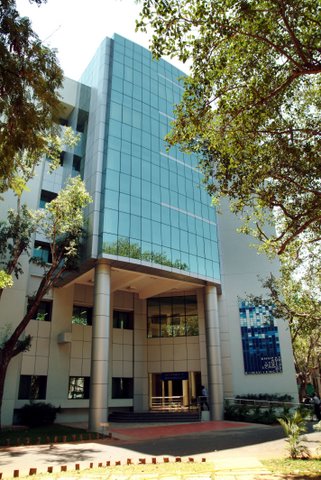Team:IIT Madras
From 2008.igem.org
Sayashkumar (Talk | contribs) |
Sayashkumar (Talk | contribs) m |
||
| Line 13: | Line 13: | ||
{|align=center width=80% | {|align=center width=80% | ||
| - | |rowspan=2| ''Engineering Biology''. The next quantum leap in understanding biological systems will be driven by attempts to engineer living organisms. This effort brings with it it's own fresh set of challenges and problems. iGem serves as the perfect testbed for | + | |rowspan=2| ''Engineering Biology''. The next quantum leap in understanding biological systems will be driven by attempts to engineer living organisms. This effort brings with it it's own fresh set of challenges and problems. iGem serves as the perfect testbed for this class of problems, often termed as synthetic biology. |
| - | After a few months of brainstorming, team IIT Madras puts forward this question, ''Is it possible to make bacteria respond to physical changes in a customized way?'' | + | After a few months of brainstorming, team IIT Madras puts forward this question, <blockquote>''Is it possible to make bacteria respond to physical changes in a customized way?''</blockquote> |
| - | First, '' | + | First, ''"physical changes"''. Why stress on physical changes? For the most part, we've seen synthetic circuits designed to be chemically induced via a limited bag of reagents. These chemical induction techniques form the basis for almost all biological engineering but we aim to expand the horizon by bringing in an almost untapped method of induction, ''physical changes''. This induction technique would, in effect, imply a departure from the ideal environmental conditions conducive for bacterial growth. In microbiology, this sort of altered environment is defined as a ''stress''. So, our physical changes are equivalent to subjecting bacteria to a ''stress''. |
| - | Second, '' | + | Second, ''"respond in a customized way"''. We should be able to tap into the response that bacteria may produce under stress. In the context of genetic engineering, this is the ability to express a gene based on these stresses as an input signal. This entry point into the response circuitry of bacteria opens a crucial window into the nature of environmental adaptation. Customization would allow us to launch our own genetic programs as appropriate for the problem at hand. |
| - | + | An environmentally induce-able response has the potential to take genetic circuits to a much more intelligent phase. It opens up the door for a smart design strategy for genetic circuits wherein we don't need to externally monitor and induce genes based on our judgement/measurements. This feature, in some sense, lets the gene ''take care of itself''. They switch on and switch off on their own as required. ''A smart response''. Neither constitutive ''(always on)'' nor blind induction based. | |
| - | With the problem statement defined as above, | + | With the problem statement defined as above, our team of 6 undergraduate students set out to provide a solution. The additional constraints to the problem were that to be conformant with the BioBrick standards and to maximize the regulation of such designed constructs to be of maximum utility to the end user. |
Take a look into our detailed design documents to know more about the project, the bacterial [[Team:IIT_Madras/Project|''StressKit'']]. | Take a look into our detailed design documents to know more about the project, the bacterial [[Team:IIT_Madras/Project|''StressKit'']]. | ||
Revision as of 04:16, 16 September 2008
| Home | About Us | Project Details | Notebook |
|---|
Overview
Engineering Biology. The next quantum leap in understanding biological systems will be driven by attempts to engineer living organisms. This effort brings with it it's own fresh set of challenges and problems. iGem serves as the perfect testbed for this class of problems, often termed as synthetic biology.
After a few months of brainstorming, team IIT Madras puts forward this question, Is it possible to make bacteria respond to physical changes in a customized way? First, "physical changes". Why stress on physical changes? For the most part, we've seen synthetic circuits designed to be chemically induced via a limited bag of reagents. These chemical induction techniques form the basis for almost all biological engineering but we aim to expand the horizon by bringing in an almost untapped method of induction, physical changes. This induction technique would, in effect, imply a departure from the ideal environmental conditions conducive for bacterial growth. In microbiology, this sort of altered environment is defined as a stress. So, our physical changes are equivalent to subjecting bacteria to a stress. Second, "respond in a customized way". We should be able to tap into the response that bacteria may produce under stress. In the context of genetic engineering, this is the ability to express a gene based on these stresses as an input signal. This entry point into the response circuitry of bacteria opens a crucial window into the nature of environmental adaptation. Customization would allow us to launch our own genetic programs as appropriate for the problem at hand. An environmentally induce-able response has the potential to take genetic circuits to a much more intelligent phase. It opens up the door for a smart design strategy for genetic circuits wherein we don't need to externally monitor and induce genes based on our judgement/measurements. This feature, in some sense, lets the gene take care of itself. They switch on and switch off on their own as required. A smart response. Neither constitutive (always on) nor blind induction based. With the problem statement defined as above, our team of 6 undergraduate students set out to provide a solution. The additional constraints to the problem were that to be conformant with the BioBrick standards and to maximize the regulation of such designed constructs to be of maximum utility to the end user. Take a look into our detailed design documents to know more about the project, the bacterial StressKit. How successful was the approach? Browse through the experiments notebook to find out. To know more about IIT Madras and who exactly we are,click here! | |
 "
"

